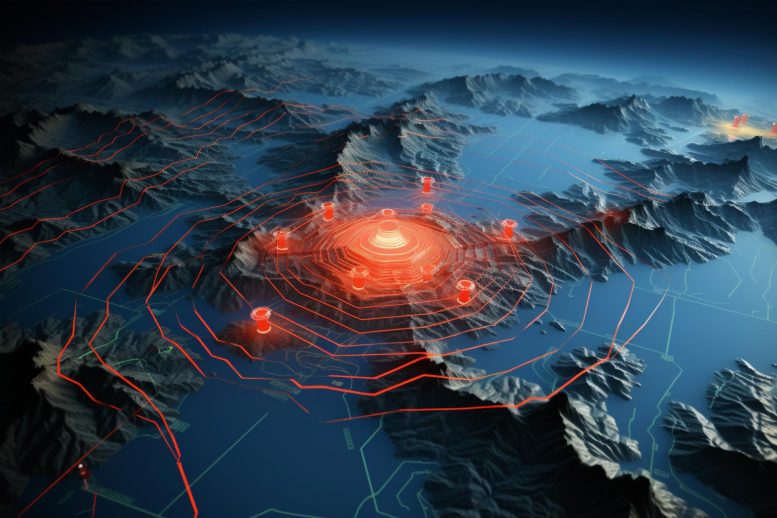[ad_1]
Analysis of GPS weather-gathering info reveals a preliminary portion of fault slip earlier than earthquakes
By Walter Beckwith, American Affiliation for the Enchancment of Science (AAAS)
July 22, 2023

A complete analysis of GPS timeline info suggests {that} a preliminary portion of fault slip happens two hours earlier than main earthquakes. Nevertheless, the present lack of monitoring system functionality to detect such landslides on the dimensions of single earthquakes stays a significant downside for clever earthquake prediction.
A worldwide scientific evaluation of GPS timeline info from almost 100 main earthquakes suggests the existence of a precursor to a portion of fault slip that happens roughly two hours earlier than seismic rupture.
In a associated perspective, Roland Bürgmann writes: If it may be confirmed that earthquake nucleation sometimes features a precursor to part of an hour, and the means could possibly be developed to measure it reliably, a preliminary warning could possibly be issued.
The hunt for predicting giant earthquakes is a long-standing, but elusive objective.
The drawback of short-term earthquake forecasting
Brief-term earthquake prediction, which incorporates issuing a warning minutes to months earlier than an earthquake, will rely upon the presence of a transparent and observable geophysical precursor. Earlier retrospective investigations have indicated that sluggish aseismic slip could possibly be seen on faults earlier than the primary shock, serving as a doable precursor. Nevertheless, the connection between these observations and seismic ruptures stays unclear. This uncertainty arises as a result of these observations don’t instantly precede an event and customarily happen with out a subsequent earthquake, leaving the existence of an precise precursor sign for predicting large earthquakes uncertain.
A worldwide seek for precursor fault slips
On this evaluation, Quentin Bletery and Jean-Mathieu Nocquet current a complete world trying to find short-term precursor faults that slip earlier than giant earthquakes. Utilizing high-speed GPS time-series info from 3,026 geodetic stations all over the world, Bletery and Nocquet estimated fault displacement as much as two hours earlier than 90 utterly completely different earthquakes of magnitude 7 and better. Statistical evaluation of this info revealed a brittle signal in line with a variety of exponential acceleration of fault slip close to the earthquake hypocenter that started about two hours earlier than rupture.
That means and limits of the evaluation
In line with the authors, these outcomes counsel that many giant earthquakes both triggered an early a part of the slip, or the observations might symbolize the latter half of a plan that’s bigger and harder to measure than the preliminary slip. Regardless of presenting proof of a precursor sign from earlier large earthquakes, Bletery and Nocquet warning that present earthquake monitoring items lack the security and accuracy wanted to detect or monitor the size-precursor slippage of given particular person earthquakes.
Bürgmann writes: Though Bletery and Nocquet’s outcomes counsel that there could also be a preliminary half of an hour’s period, it’s unclear whether or not such slow-flow accelerations are clearly related to giant earthquakes or can ever be measured for particular person occasions with the precision mandatory to supply a helpful warning.
Conclusion
Evaluation of GPS timeline info from almost 100 main earthquakes exhibit {that} a preliminary portion of fault slip happens about two hours earlier than seismic rupture. This discovery might truly result in dependable precursor measurement gadgets and the issuing of warnings for impending earthquakes. Nevertheless, present limitations in info monitoring pose main challenges for sensible implementation.
Frequent questions
1. What does analysis of GPS timeline details about earthquakes reveal?
The evaluation suggests the existence of a precursor to part of the fault slip that happens about two hours earlier than the seismic rupture.
2. Can earthquake prediction be improved with outcomes?
If the existence of a half hour lengthy precursor could possibly be confirmed and a dependable measurement method could possibly be developed, a precursor warning might certainly be issued.
3. What’s the drawback of predicting earthquakes within the brief time period?
The issue lies in discovering clear and observable geophysical precursor indicators that instantaneously precede earthquakes and have a dependable correlation with seismic ruptures.
4. What did the worldwide seek for precursor defects contain?
The evaluation consisted of analyzing high-speed GPS time-series info from a whole bunch of geodetic stations all over the world to evaluate fault displacement as much as two hours earlier than main earthquakes.
5. What are the bounds of the evaluation?
Present earthquake monitoring items lack the security and accuracy wanted to detect or monitor precursor landslides the dimensions of single particular person earthquakes, making sensible implementation troublesome.
For extra info, see this hyperlink
[ad_2]
To entry further info, kindly discuss with the next link
